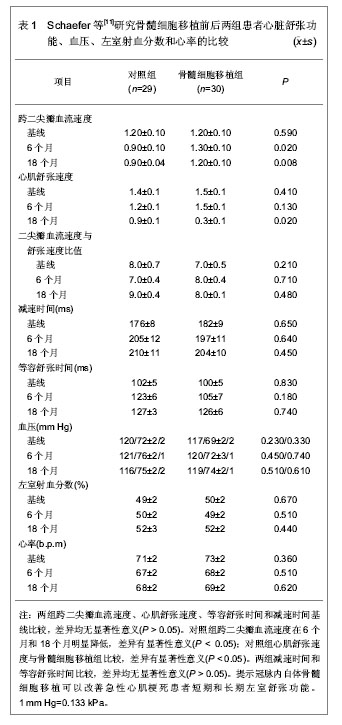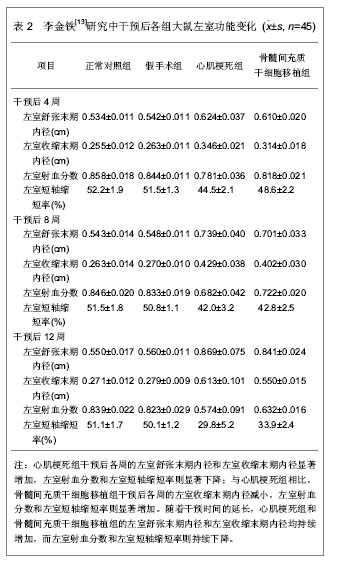| [1] Orlic D, Kajstura J, Chimenti S, et al.Bone marrow cells regenerate infarcted myocardium.Nature.2001; 410(6829): 701-705.[2] Schächinger V, Erbs S, Elsässer A, et al. Intracoronary bone marrow-derived progenitor cells in acute myocardial infarction. N Engl J Med. 2006;355(12):1210-1221.[3] Strauer BE, Brehm M, Zeus T, et al.Intracoronary, human autologous stem cell transplantation for myocardial regeneration following myocardial infarction.Dtsch Med Wochenschr.2001;126(34-35):932-938.[4] Kang HJ, Lee HY, Na SH, et al.Differential effect of intracoronary infusion of mobilized peripheral blood stem cells by granulocyte colony-stimulating factor on left ventricular function and remodeling in patients with acute myocardial infarction versus old myocardial infarction: the MAGIC Cell-3-DES randomized, controlled trial.Circulation. 2006 Jul 4;114(1 Suppl):I145-151.[5] 王建安,余伟芳.干细胞治疗在心血管领域现状和展望[J].医学研究杂志,2008,37(10):6-9.[6] Hendrikx M, Hensen K, Clijsters C, et al.Recovery of regional but not global contractile function by the direct intramyocardial autologous bone marrow transplantation: results from a randomized controlled clinical trial.Circulation. 2006;114 (1 Suppl): I101-107.[7] Meyer GP, Wollert KC, Lotz J, et al.Intracoronary bone marrow cell transfer after myocardial infarction: eighteen months' follow-up data from the randomized, controlled BOOST (BOne marrOw transfer to enhance ST-elevation infarct regeneration) trial.Circulation. 2006;113(10):1287- 1294.[8] Meyer GP, Wollert KC, Lotz J, et al.Intracoronary bone marrow cell transfer after myocardial infarction: 5-year follow-up from the randomized-controlled BOOST trial.Eur Heart J.2009;30(24):2978-2984.[9] Janssens S, Dubois C, Bogaert J, et al.Autologous bone marrow-derived stem-cell transfer in patients with ST-segment elevation myocardial infarction: double-blind, randomised controlled trial.Lancet.2006;367(9505):113-121.[10] Tse HF, Yiu KH, Lau CP.Bone marrow stem cell therapy for myocardial angiogenesis.Curr Vasc Pharmacol.2007; 5(2): 103-112.[11] Schaefer A, Meyer GP, Fuchs M, et al.Impact of intracoronary bone marrow cell transfer on diastolic function in patients after acute myocardial infarction: results from the BOOST trial.Eur Heart J. 2006;27(8):929-935.[12] 林茂海,苏津自,许昌声.肾上腺髓质素基因转染增强骨髓间充质干细胞移植对心肌梗死大鼠心室重构及心功能的影响[J].2009, 25(9):1692-1699.[13] 李金铁.急性心肌梗死经骨髓间充质干细胞移植前后Cx43、Cx45与心电生理变化的实验研究[D].广西:广西医科大学, 2009: 4-9.[14] 张翔,张彤,李文,等.自体外周血干细胞移植对急性心肌梗死患者左室重构和心功能的影响[J].中国心血管病研究,2008,6(5): 349-351.[15] 曾建平.骨髓干细胞移植改善猪急性心梗后左室重构及相关机制的研究[D].湖南:中南大学,2008:1-8.[16] Schächinger V, Assmus B, Honold J, et al.Normalization of coronary blood flow in the infarct-related artery after intracoronary progenitor cell therapy: intracoronary Doppler substudy of the TOPCARE-AMI trial.Clin Res Cardiol. 2006; 95(1):13-22.[17] Erbs S, Linke A, Adams V, et al.Transplantation of blood-derived progenitor cells after recanalization of chronic coronary artery occlusion: first randomized and placebo-controlled study.Circ Res. 2005;97(8):756-762.[18] Poh KK, Sperry E, Young RG, et al.Repeated direct endomyocardial transplantation of allogeneic mesenchymal stem cells: safety of a high dose, "off-the-shelf", cellular cardiomyoplasty strategy.Int J Cardiol. 2007;117(3):360-364. |

